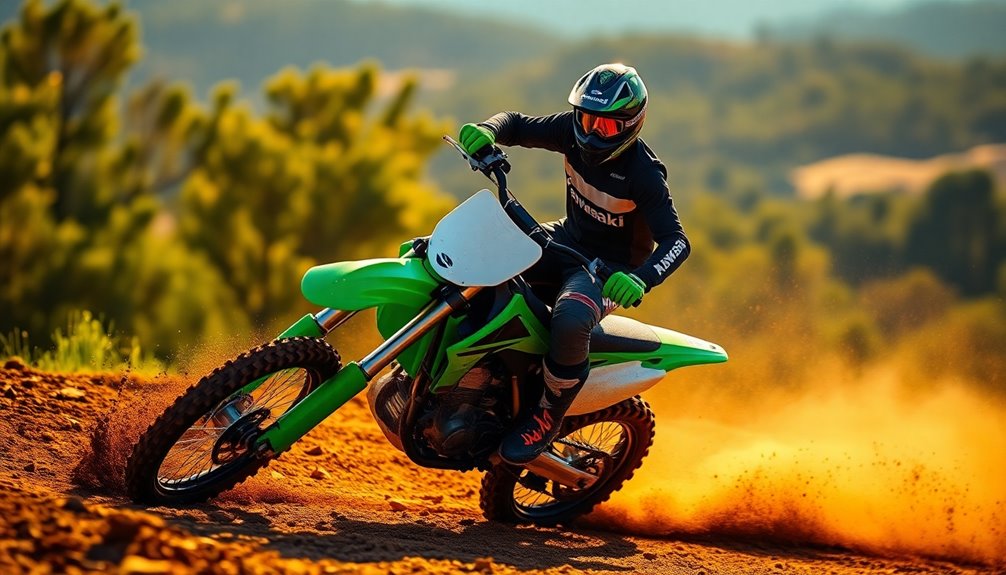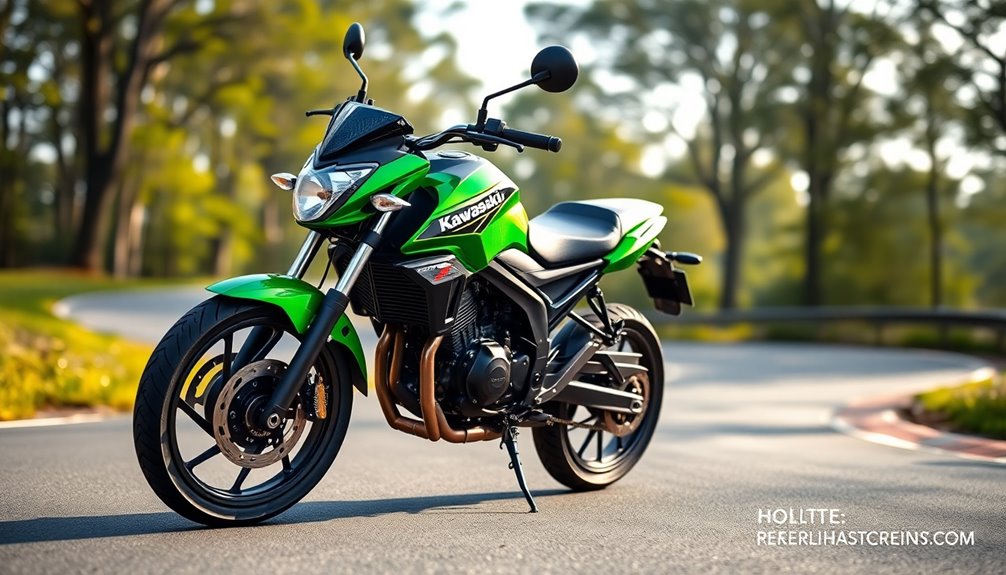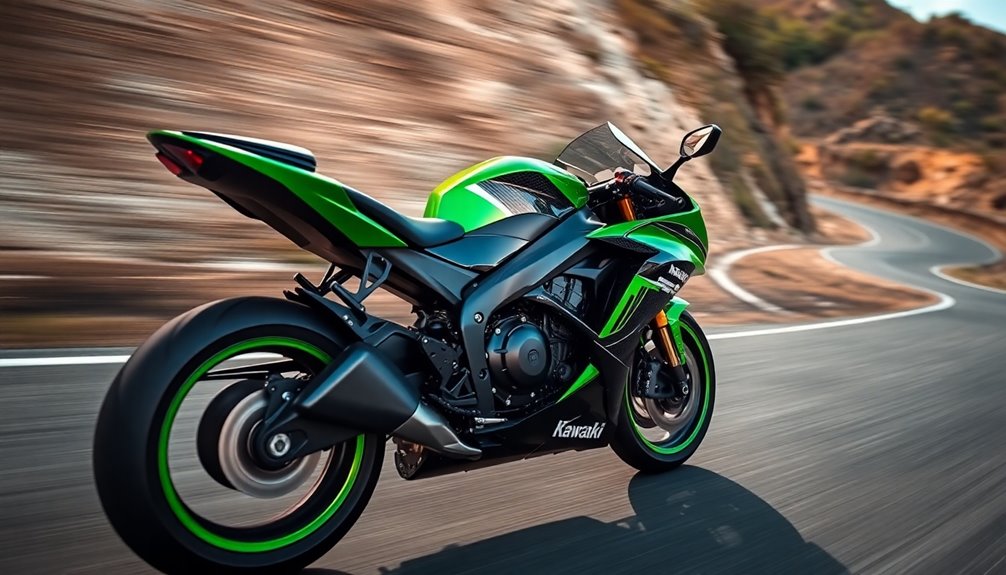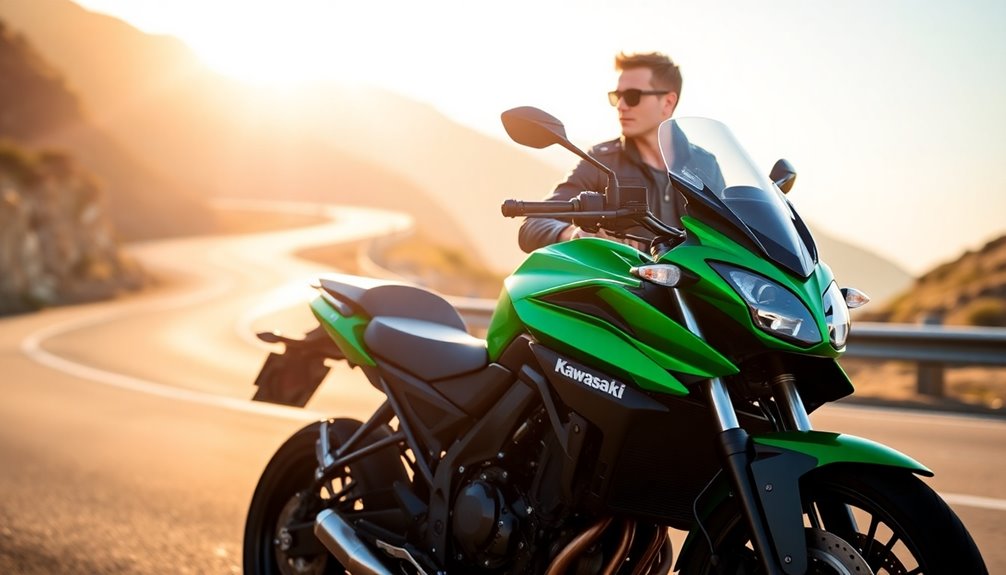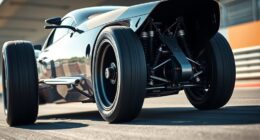The Kawasaki Ninja 250 strikes a perfect balance between being a starter bike and offering a speedy thrill. Weighing just 172 kg, it delivers a top speed of around 90 mph, making it agile for both commuting and spirited rides. Its lightweight design and accessible seat height cater to a range of riders, while its comfortable seat makes longer journeys enjoyable. The bike's performance metrics, including a 0-60 mph time of about 7.08 seconds, impress many new riders. With its user-friendly features and solid community support, you'll discover why it's a favorite among beginners and experienced riders alike.
Key Takeaways
- The Kawasaki Ninja 250 has a top speed of approximately 90 mph, making it suitable for both beginner riders and experienced enthusiasts.
- Its lightweight design and agile handling provide an engaging and thrilling riding experience, perfect for navigating city streets and twisty roads.
- With a 0-60 mph acceleration in about 7.08 seconds, it offers a balanced mix of performance and control for new riders.
- The bike's high-revving engine and sporty design appeal to those seeking a fun, responsive ride without excessive power.
- As a starter bike, its manageable speed and comfort features help build confidence for novice riders while still delivering excitement.
Lightweight Chassis Design
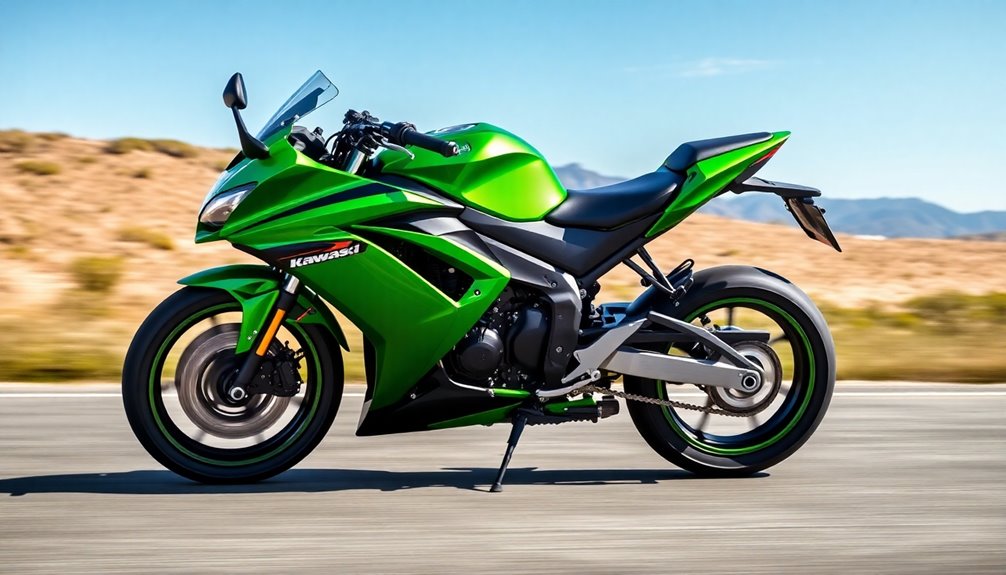
The Kawasaki Ninja 250's lightweight chassis design plays a crucial role in its performance and handling. With a diamond-shaped steel frame and a tubular design, this bike is engineered for agility.
You'll appreciate how its compactness, thanks to the narrow parallel twin-cylinder engine, contributes to a streamlined chassis that feels nimble on the road. The engine's design also emphasizes strong performance at low- and mid-range speeds, ensuring a responsive experience for riders.
The suspension system further enhances your riding experience. The front features telescopic forks offering 140 mm of travel, while the rear employs a UNI-TRAK single shock with 130 mm of travel, providing the stability you need for confident cornering.
This combination allows you to tackle various terrains with ease.
When it comes to braking, the Ninja 250 doesn't disappoint. It's equipped with high-performance petal disc brakes that ensure excellent control and braking force.
The front brakes, with options for 290 mm or 260 mm discs, and rear options at 220 mm or 230 mm, give you the stopping power you need.
Finally, the ergonomics are designed for comfort, with a seat height of 740 mm or 775 mm, ensuring you can handle the bike effectively while enjoying the ride.
Performance Metrics Explained
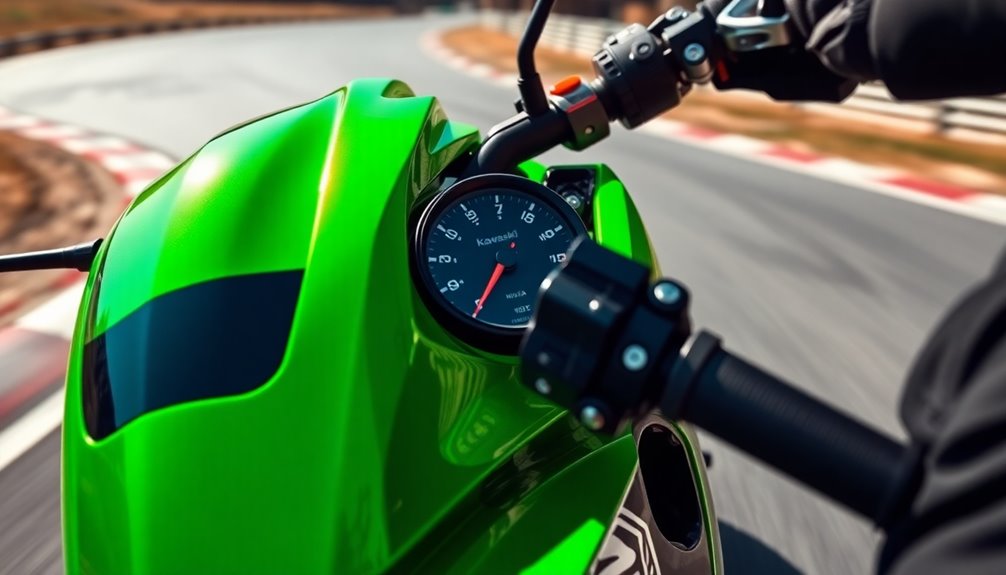
When it comes to the Kawasaki Ninja 250, understanding its performance metrics is crucial for unlocking its potential.
You'll want to look at maximum velocity achieved, throttle response dynamics, and how the aerodynamic fairing design plays a role in overall speed. This model is renowned for its 20-30% increase in mid-range power, which enhances its responsiveness on the road. Additionally, engine tuning options can further optimize performance, making the bike even more thrilling to ride.
Each of these factors contributes significantly to your riding experience and the bike's capabilities on the road.
Maximum Velocity Achieved
Achieving maximum velocity on the Kawasaki Ninja 250 involves understanding various performance metrics that influence speed. The claimed top speed is 97.56 mph, but in real-world conditions, you can typically expect around 90 mph due to aerodynamic limitations. However, in ideal conditions or with drafting, you might push it to 110 mph. Keep in mind that the speedometer can overestimate your actual speed by 10-15%.
When it comes to acceleration, the Ninja 250R can reach 0-60 mph in about 7.08 seconds, with some variations depending on rider weight and weather conditions. To optimize your launch times, you'll need to employ aggressive clutch slipping. This bike's power delivery is particularly effective, as it achieves peak power at high RPMs, providing a thrilling ride experience.
These acceleration figures are competitive, matching some entry-level cars from the last decade. In quarter-mile performance, the Ninja 250R clocks around 15.86 seconds at 83.7 mph, though this can improve with proper tuning and riding conditions.
While it offers a sporty experience, be aware that more powerful vehicles, like the Volkswagen Tiguan 2.0T, can outperform it in this metric.
Throttle Response Dynamics
How does throttle response affect your riding experience on the Kawasaki Ninja 250? Throttle response is critical; it influences how smoothly and predictably you can control your bike.
If you encounter a delayed throttle response, even after routine maintenance, it might signal fuel delivery or ignition issues. This can lead to frustrating moments where the bike doesn't react as expected when you twist the throttle. A potential cause for this issue could be a vacuum leak affecting the carburetor's performance.
On the other hand, a jerky throttle response, particularly in lower gears, can be a challenge. This sensitivity may stem from throttle cable tension or carburetor problems, which can make your ride feel erratic.
To enjoy a smoother experience, you might need to adjust your riding style. Focusing on higher RPMs can help overcome the Ninja 250's limited low-end torque.
Maintaining your throttle cables, ensuring they're properly lubricated and adjusted, is essential for optimal performance. Regularly checking your carburetors and fuel system for blockages will also enhance your throttle response.
Ultimately, understanding these dynamics allows you to adapt your technique, making your ride on the Ninja 250 more enjoyable and responsive.
Aerodynamic Fairing Design
The Kawasaki Ninja 250's performance isn't just about its engine and throttle response; aerodynamic fairing design plays a significant role in maximizing your riding experience. The fairing enhances aerodynamic efficiency, significantly reducing air resistance. This translates to increased top speed and improved handling, especially at high velocities.
Key components like the front fairing cover, winglets, and streamlined bodywork work together to optimize airflow. Air ducts and integrated windscreens protect you from wind and debris while minimizing wind buffeting. You'll notice how these features not only enhance stability but also improve fuel efficiency, allowing you to ride longer without frequent stops. Furthermore, the bike is part of a wide range of products available on platforms like AliExpress, making it accessible for enthusiasts worldwide.
Design considerations emphasize lightweight yet strong materials, ensuring durability without compromising speed. Optimized airbox designs boost intake efficiency, while revised rigidity eliminates unwanted noise, creating a smoother ride.
Plus, the fairing integrates seamlessly with the bike's original frame and suspension, maintaining aesthetic appeal.
Rider Comfort and Ergonomics

Considering its design and features, the Kawasaki Ninja 250 offers a range of rider comfort and ergonomic benefits. With a seat height of just 29.3 inches, it's accessible for shorter riders, making it a great choice for those around 5'9" to 6'3". If you're shorter, you can potentially enhance comfort with seat adjustments or even shaving the seat down.
The wide and soft stock seat garners praise for its comfort, though aftermarket options are limited. While the lightweight design contributes to agility, it also means you might feel a bit of wind resistance at higher speeds, which could be a drawback for some. Integrated luggage hooks add practicality, catering to your everyday needs. Additionally, the Ninja 250's low operating costs, including affordable insurance rates, make it an attractive option for budget-conscious riders. The bike also benefits from lightweight design features that enhance maneuverability. Maintaining emotional alignment while riding can also contribute to a more enjoyable experience. Furthermore, having a solid understanding of retirement savings options can be beneficial for long-term financial planning after enjoying your riding experiences. A well-planned budget can help you manage expenses related to your bike and its maintenance effectively.
However, the suspension can be undersprung for average-sized adults, affecting handling during turns. Upgrading to a better rear shock can significantly improve this aspect.
The Ninja 250's wet weight of 374 pounds makes it easy to maneuver, especially in city and twisty rides. Just keep in mind that its light weight may compromise stability at high speeds, which is worth considering depending on your riding style and experience.
Owner Insights: Real Experiences
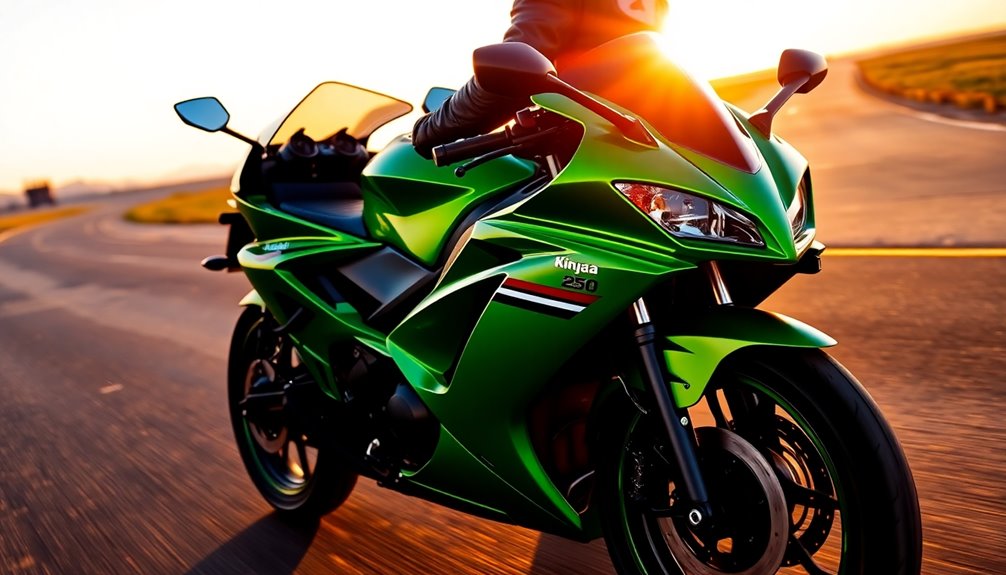
Rider comfort and ergonomics play a significant role in the overall ownership experience of the Kawasaki Ninja 250. Owners often find that this bike shines in city driving and twisty roads, making it an excellent choice for daily commutes. With a top speed of around 95 mph, it can handle urban traffic well, although it's not meant for long highway trips. Many riders appreciate its lightweight design, which makes maneuvering through tight corners a breeze. Additionally, many Ninja 250s are available on local classifieds, offering a variety of options for potential buyers.
However, you might notice some limitations. The suspension can feel undersprung, especially for normal-sized adults, and while the brakes are adequate, they aren't exceptional. You'll need to work the gears to maintain speed, which can be a great learning experience. Riders often mention that the Ninja 250R humbles them, pushing them to develop better riding skills rather than relying on sheer power. Proper routine maintenance is crucial to keep the bike in optimal condition. Audiometric testing can also be beneficial for riders who may have sensitivity to noise, ensuring they choose the right protective gear for their rides. Additionally, many riders find that the bike's water efficiency contributes to lower running costs, making it an economical choice.
On the downside, heat emission can be an issue in heavy traffic. Maintenance is typically easy and cost-effective, adding to the overall satisfaction of ownership.
Market Positioning Against Rivals
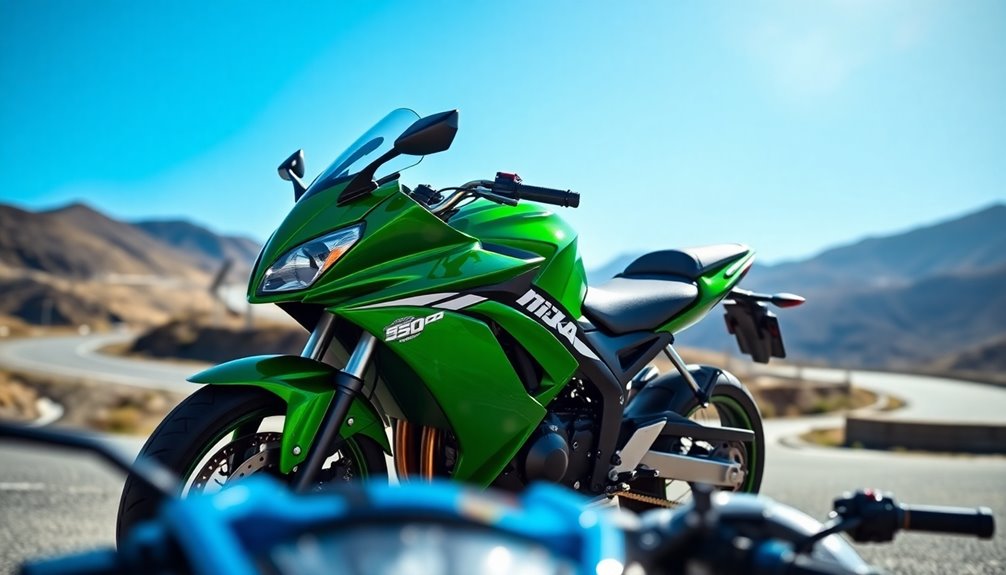
When comparing the Kawasaki Ninja 250R to its rivals, it's clear that this bike stands out in several key areas. The Ninja boasts a high-revving twin-cylinder engine that delivers about 29 horsepower, offering more punch for passing compared to the Honda CBR250R, especially above 9,000 rpm.
While the CBR250R is lighter and easier to maneuver in traffic, the Ninja excels in handling and cornering due to its low center of gravity and sportbike styling. Tuning options for motorcycles can significantly enhance their performance, similar to how Toyota Tacoma 2007 tuning improves handling and comfort. In fact, proper tuning can help achieve optimal engine performance that complements the Ninja's capabilities. Additionally, the principles of utilitarian thinkers suggest that maximizing performance benefits both the rider's experience and overall safety. Moreover, the Ninja 250R's advanced design incorporates innovative technology that enhances stability and control during high-speed maneuvers.
In twisty conditions, the Ninja 250R's aerodynamics and design give it an advantage, though it requires more skill and rider input to maximize its potential. Additionally, the Ninja 250R's design shares similarities with larger sport bikes, enhancing its appeal among new riders.
Fuel efficiency is another consideration; the Ninja offers around 49.7 mpg, which is lower than the CBR250R's 64.3 mpg. However, the Ninja's larger 4.8-gallon tank provides a better range than the Yamaha WR250X.
Visually, the Ninja 250R's sporty design appeals to new riders, particularly women, making it a top choice for beginners.
While it requires premium fuel and more maintenance, its performance and appeal solidify its place in the market against competitors.
Performance Enhancing Accessories
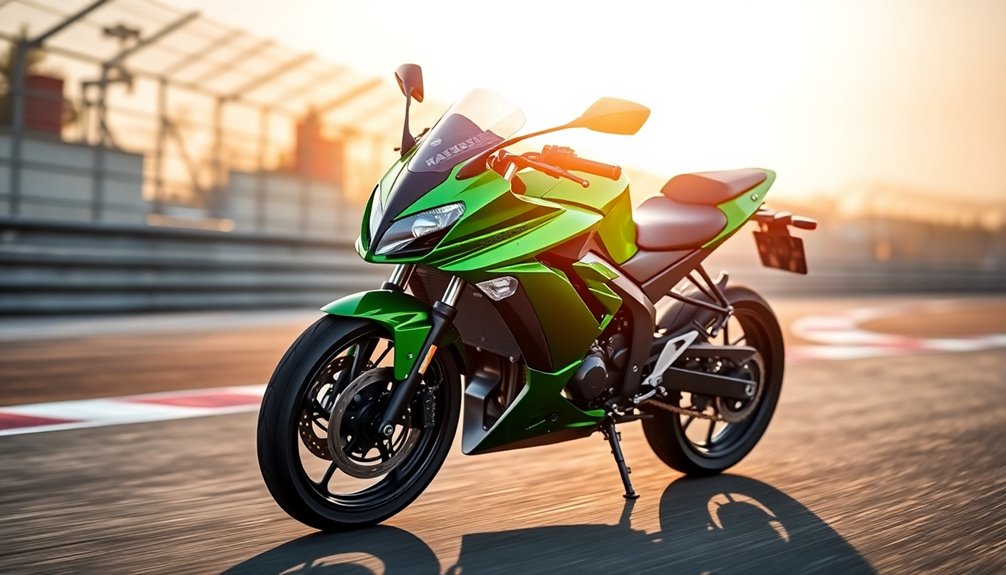
The Kawasaki Ninja 250R's performance can be further enhanced with a variety of accessories that cater to both power and handling.
For starters, consider engine modifications like increasing the compression ratio or re-boring the engine. These tweaks can elevate your bike's power output significantly. Pair these upgrades with head work and cam modifications to achieve impressive figures, like 35.92 bhp and 16.79 lb-ft of torque.
Upgrading your exhaust system is another effective way to boost performance. A performance exhaust, like the Scorpion Serket Taper Full System, can enhance power, especially at higher RPMs. Additionally, Moto Machines offers a wide selection of parts for the Kawasaki Ninja 250R to ensure you find the right upgrades for your bike.
Slip-on options, such as the MIVV Exhaust GP Slip-On, reduce weight while improving responsiveness.
Don't overlook air intake upgrades. A high-performance air filter can improve airflow and, when combined with exhaust modifications, can really enhance engine response.
Finally, there are additional accessories to improve handling and comfort. Upgrading your clutch lever and grips can enhance your control, while a windshield upgrade can improve aerodynamics.
With these performance-enhancing accessories, you can truly maximize your Ninja 250R's capabilities and elevate your riding experience.
Cost and Dealer Locations

Looking to snag a Kawasaki Ninja 250R? You'll find that the brand new model has an MSRP of around $3,000, while a clean used model from 2007 runs approximately $2,999. Not only is the Ninja 250R affordable, but it also boasts impressive fuel efficiency, allowing you to save money with up to 50-60 miles per gallon. The maintenance costs are low, requiring only occasional oil changes and tire replacements, and you'll generally face lower insurance costs compared to larger motorcycles.
When it comes to purchasing, you can visit various authorized Kawasaki dealers nationwide, including Free Ride Powersports in Ann Arbor, MI, which features a range of new and used models. Many dealers offer financing options, making it easier for you to get on the road. Keep an eye out for promotions as well; some dealers provide limited-time discounts or special financing rates, like 1.95% for 36 months. Plus, new models come with a manufacturer's warranty for added peace of mind. So, whether you're buying new or used, the Ninja 250R offers excellent value for your investment, especially considering its status as an entry-level bike in the Kawasaki Ninja lineup.
First-Time Motorcycle Enthusiasts

For first-time motorcycle enthusiasts, the Kawasaki Ninja 250R is an appealing option that balances performance and manageability. With a top speed of around 90 mph, it offers a thrilling experience without overwhelming new riders. Accelerating from 0 to 60 mph in just 7.08 seconds, you'll enjoy a satisfying rush when you twist the throttle.
The Ninja 250R's lightweight design at 172 kg enhances maneuverability, making it easier for you to navigate city streets or twisty mountain roads. However, you'll need to adjust to its 'borderline manic behavior,' especially during turns, where downshifting helps you stay in the power band. Additionally, the bike's smooth engine response due to electronic fuel injection contributes to an enjoyable ride.
Its smooth engine response is due to electronic fuel injection, though you might find torque limited below 8,000 rpm. As a beginner, mastering this bike can be fun, and it's more predictable than some single-cylinder options.
You'll want to invest in proper safety gear and stay informed about maintenance. Overall, the Ninja 250R is effective for varied riding conditions, whether you're commuting or hitting the highway, making it a solid choice for those just starting their motorcycling journey.
Frequent Maintenance Requirements
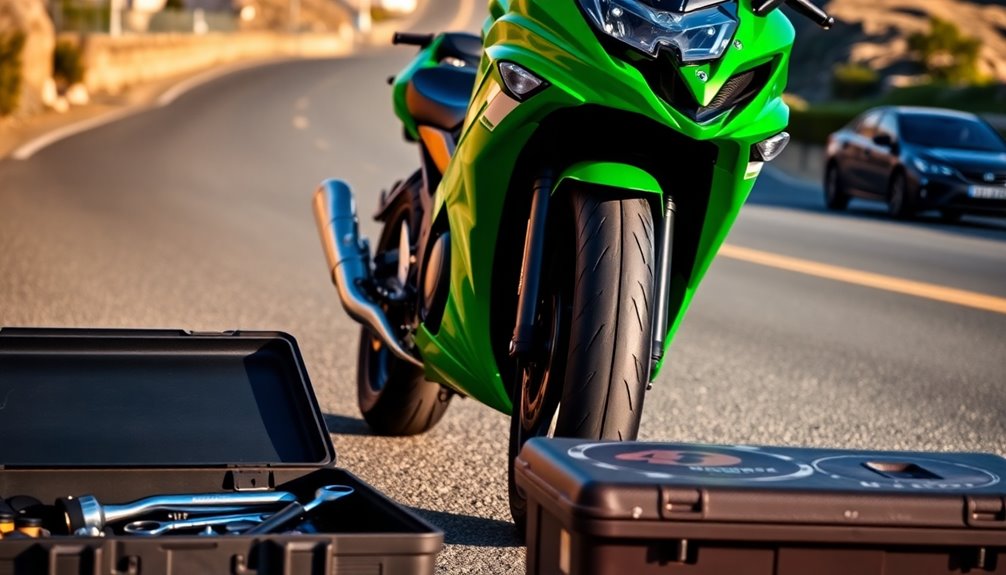
How often should you perform maintenance on your Kawasaki Ninja 250R? Regular upkeep is crucial to keep your bike running smoothly.
For the EX250-J model, you should change the oil and oil filter every 7,500 miles or annually. If you have the EX250-F model, aim for every 6,000 miles. Don't forget to inspect the valve clearances and synchronize the engine vacuum at the same intervals.
In addition to engine maintenance, you'll want to keep an eye on your brake fluid—check it every six months. Regular replacement of brake fluid is essential for maintaining optimal performance.
Inspect your brake pads, tire pressure, and tire wear regularly to ensure safety. Chain maintenance is equally important; lubricate it every 400 miles and adjust the slack every 600 miles. After washing your bike, always re-lubricate the chain to prevent rust.
Lastly, perform an annual service that includes a comprehensive checklist of inspections and part replacements.
Safety Features and Standards
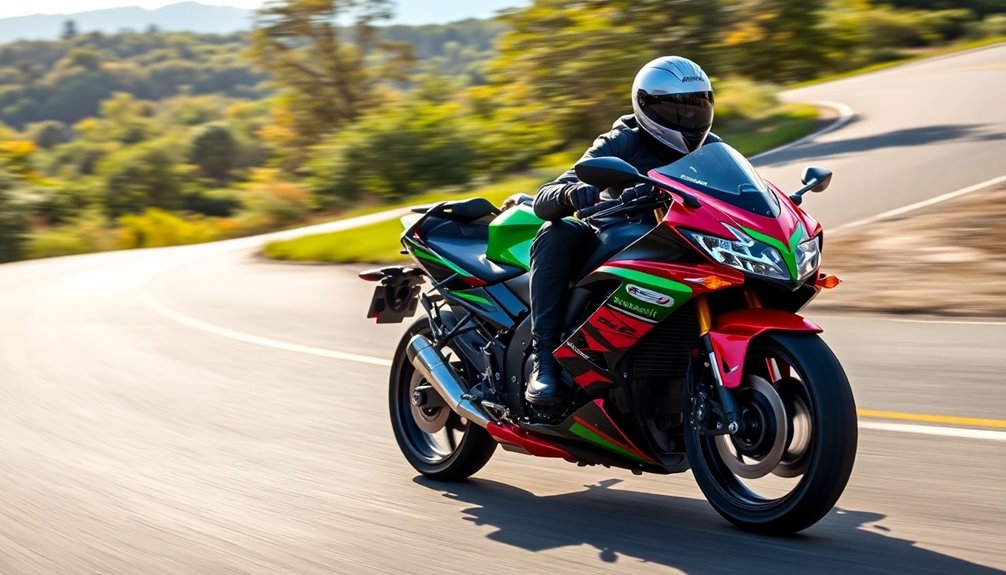
When it comes to safety features and standards, the Kawasaki Ninja 250R is designed with rider security in mind. One standout feature is the anti-lock braking system (ABS), which helps prevent wheel lockup during sudden stops. You'll appreciate the dual disc brakes—front and rear—ensuring reliable stopping power. The bike also includes a pass switch for passenger convenience, allowing you to signal when needed. To keep you informed, an engine check warning alerts you to potential issues, while an oil change indicator reminds you of maintenance needs. Visibility is enhanced with side reflectors and LED lighting for both the headlamp and tail lamp, making you more noticeable on the road. The Ninja 250R boasts adjustable headlights for better illumination control, giving you confidence during nighttime rides. Additionally, the Ninja 250R features a kerb weight of 167 kg, contributing to its stability and handling. Although the suspension features a front shock absorber and a Uni-Trak rear system, be aware that it may feel undersprung for larger riders, impacting handling in turns. With different riding modes—Sport and Road—you can tailor your experience while ensuring safety remains a priority. Overall, the Ninja 250R combines essential safety features for a secure ride, similar to how the best heat pumps enhance comfort and efficiency in various climates.
Ideal for New Riders

The Kawasaki Ninja 250R stands out as a great choice for new riders, thanks to its user-friendly features and manageable power. With a 249cc, liquid-cooled engine delivering approximately 39 horsepower, this bike provides enough punch for real-world riding without overwhelming you. The smooth acceleration, clocking in at 0-60 mph in just 5.75 to 7.72 seconds, helps you gain confidence as you learn the ropes.
Weighing around 167 kg, the Ninja 250R offers nimble handling, making it easy to navigate through city streets or twisty country roads. Its seat height of about 785 mm ensures that most riders can comfortably reach the ground, enhancing stability during stops. Additionally, its lightweight frame contributes to the bike's agility, making it an excellent option for both novice and experienced riders alike.
Plus, with a 6-speed transmission, you'll enjoy a responsive ride that adapts to various conditions. Fuel efficiency is another perk, with an impressive range of 48-74.2 mpg, allowing for longer rides without frequent stops.
Maintenance is straightforward, backed by a supportive community, making it easier for you to keep your bike in top shape. Overall, the Kawasaki Ninja 250R perfectly balances power and agility, making it an ideal starter bike for new riders like you.
Frequently Asked Questions
What Is the Ninja 250's Fuel Efficiency in City Riding?
In city riding, you can expect the Ninja 250's fuel efficiency to be lower than its highway performance. Typically, it averages around 45-50 mpg in urban conditions due to frequent stops and starts.
To maximize your mileage, try to maintain a steady throttle and avoid aggressive acceleration.
Keeping an eye on tire pressure and making sure your bike's well-maintained can also help improve your fuel economy during city commutes.
How Does the Ninja 250 Handle During Bad Weather?
When you're riding the Ninja 250 in bad weather, you'll notice that damp spots can really affect traction.
The firm suspension might feel less forgiving on rough roads, making handling tricky. If your tires are still new, grip could be compromised on wet surfaces.
While the bike remains stable overall, you'll want to adjust your riding style to account for potential traction issues, especially on bumpy, slippery conditions.
Stay cautious!
What Aftermarket Modifications Are Popular for the Ninja 250?
When you're looking to enhance your Kawasaki Ninja 250, popular aftermarket modifications include installing a slip-on exhaust for improved performance and re-jetting the carbs to optimize engine efficiency.
You might also consider upgrading the air filter for better airflow.
For aesthetics, a fender eliminator kit and flush-mounted turn signals can significantly improve the bike's look.
Don't forget about safety; frame sliders and engine guards can protect your investment in case of a drop.
What Is the Weight Limit for Riders on the Ninja 250?
The weight limit for riders on the Ninja 250 is approximately 340 lb, including the rider, passenger, and any cargo.
Exceeding this limit can negatively impact the bike's performance and safety. If you're close to this limit, especially on freeways, it's not recommended.
Heavier riders may face reduced acceleration and compromised handling, so consider your weight and any additional load before hitting the road for a safe and enjoyable ride.
Can the Ninja 250 Be Used for Long-Distance Touring?
Yes, you can use the Ninja 250 for long-distance touring, but it has its limitations.
You'll find the ride comfortable for shorter trips, but fatigue may set in on longer journeys due to the stock seat and ergonomics.
If you're willing to make some modifications, like upgrading the seat or changing sprockets, you can enhance comfort and fuel efficiency.
Just remember to adjust your riding style to better manage highway speeds and crosswinds.


